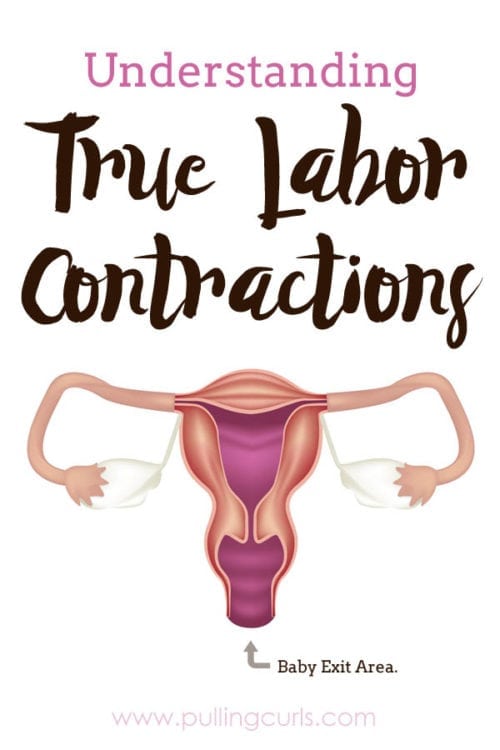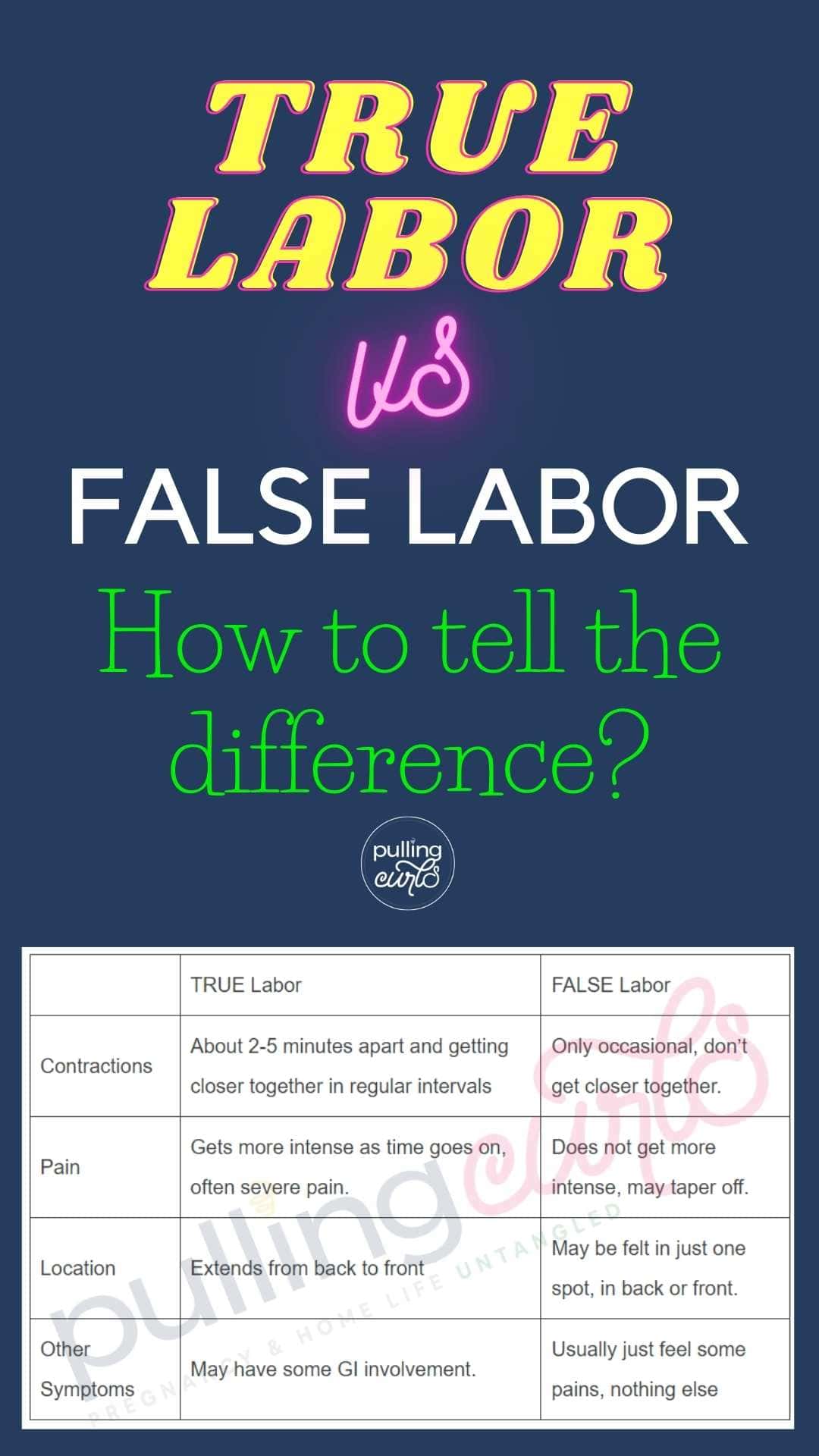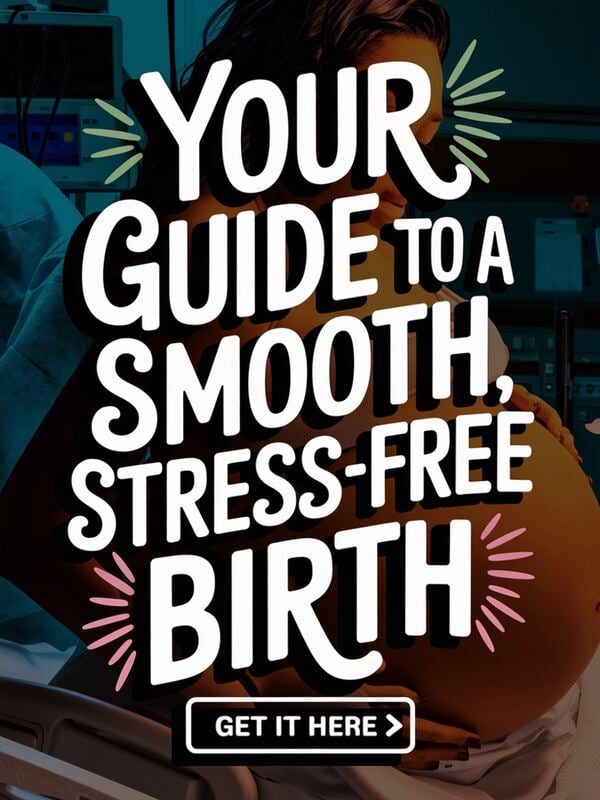True labor contractions give some signs that labor has started. We’ll talk how to time early contractions and what to watch for so you know if you’re having real labor contractions (vs Braxton hicks contractions) — AND what to do if you’re sent home from the hospital in early labor.

True labor contractions have some definite signs of labor approaching. Of course, it’s different for everyone, so let’s read on to see what you should watch for.
But first — why listen to me?
First off, hello! I’m Hilary — many people know me as The Pregnancy Nurse 👩⚕️. I have been a nurse since 1997 and I have 20 years of OB nursing experience, I am also the curly head behind this website Pulling Curls and The Online Prenatal Class for Couples. 🩺 I’ve talked to THOUSANDS of patients trying to decide if they were really in labor or just had false alarms. So, I think I’m an expert on this one.
But, of course you’ll want to call your health care provider if you have any questions as to if you’re in labor. This article is purely informational and not meant as medical advice.
What are True Labor Contractions?
TRUE labor contractions from your uterus cause your cervix to open. Contractions prior to that just soften your cervix and prepare it for labor (many call these braxton-hicks contractions) True labor contractions increase in location (more broad across your belly/back), intensity (more painful), and get closer together.
And yes, if you think labor alone is confusing, wait until you pair it with going into the hospital — which is why I always recommend this.
Labor SOUNDS like it will be really obvious. However, a lot of you might wonder as you feel aches and pains if “that” is “it”. Towards the end of your pregnancy you will have many contractions and they will likely not be in a regular pattern for a bit.
I’ve said it before and I’ll say it again — TV and movies have NOT done us any favors in our impression of how labor starts and progresses. Much like everything else, labor in real life is a lot different than how it is on TV.
But, these are some pretty good points for the majority of people. Want to know more about labor — don’t miss my page – Am I in Labor Quiz.
True Labor Contractions:
** These are not hard and fast rules, pay attention to your body, your doctor and your gut. As always, never take the advice of something you read or hear, over the advice of your doctor. **
True labor contractions are only great when you’re after 36-37 weeks (almost at the end of your third trimester. Prior to that, early labor contractions can be problematic (you want to go the full forty) and you will want to call your doctor (even if it’s not office hours). Be sure to ask your health care provider what you should do when you feel contractions!
The Difference Between True and False Labor
| TRUE Labor | FALSE Labor | |
| Contractions | About 2-5 minutes apart and getting closer together in regular intervals | Only occasional, don’t get closer together. |
| Pain | Gets more intense as time goes on, often severe pain. | Does not get more intense, may taper off. |
| Location | Extends from back to front | May be felt in just one spot, in back or front. |
| Other Symptoms | May have some GI involvement. | Usually just feel some pains, nothing else |
I actually have a whole podcast on knowing if you’re going into labor
As you can tell — deciding if you’re actually in labor can be more problematic than it sounds at first mention. This is really why you need a trusted friend who can tell you what to expect and plan for as you get closer to do your due date.
Then, what is false labor?
False labor is often known as Braxton hicks contractions, or “practice contractions” — but they essentially contractions that are not opening your cervix and pushing baby into the birth canal. They can still hurt, but for some reason they aren’t strong enough to push baby into the birth canal (could be baby’s position or the readiness of the cervix).
Understanding how labor happens is something I go into in my how to go into labor guide (it’s also included in the bump to bassinet bundle).
Because they’re so similar you can often switch into “true labor” and not really realize it until you’re firmly into active labor and contractions become very frequent and painful.
Early Labor Contractions
Contractions will start out pretty randomly — but with TRUE labor, you’ll want to see them slowly form into some sort of a pattern.
With your first baby, we’d like to see the contractions every 2-3 minutes, on subsequent babies you’d probably want to head to the hospital when they’re about every 5 minutes (only because labor progresses quicker). I once had a patient come in because she’d had two contractions. I was like, “every two minutes?” She said, “not — just two — but they’re really hard!”
Spoiler alert: She wasn’t in labor.
Pro Tip: Early contractions can SOFTEN your cervix, and make you lose your mucus plug.
Often this early phase of labor is called the latent phase of labor.
You might find this post on the stages of labor on my sister site helpful.
Related Post: Is a headache a sign of labor at 38 weeks?
What does a contraction feel like?
Most women say they feel like menstrual cramps in their lower abdomen. I have a whole post on what a contraction feels like. The pain is felt when the uterus contracts.
True Contraction Timing
Do they have to last exactly a minute — no — but most PRODUCTIVE real contractions last about a minute – meaning 45 to 90 seconds. Short ones usually aren’t going anywhere big (Chapter three in my prenatal class gives all the info on how to exactly count contractions).
And like I said above, you want them every 2-5 minutes (depending on what # baby it is — you’ll want to ask your doctor about the specifics he/she recommends). That means they’re REGULAR (irregular contractions will be 3 minutes apart, then 8 minutes, then 5 — it won’t follow a pattern).
Wanting to time them, but not wanting to use your phone (I never did) something like this will work.
Pro tip: You’ll want to make SURE that baby is still moving, even if you’re contracting — check out my post on kick counts for more info on that!
How will I know when I’m having true contractions?
True labor radiates. It will usually involve your entire torso. Like someone has wrapped a scarf of pain around your midsection. Usually starting in the back and radiating towards the front (or it can go the opposite). If it’s JUST in the back or on a certain area of your belly, it may well not be quite the real deal.
Of course, I discussed a lot of this on my Signs of Labor post — it won’t be JUST contractions. There are lots of labor symptoms. Usually, there’s some other physical changes going on also, like diarrhea, some bloody show (normally a small amount of dark brown blood), changes in vaginal discharge, loss of your mucus plug, extreme fatigue possibly even leaking amniotic fluid — so, click over there to learn more about the different signs of labor.
True contractions don’t usually come alone — they come with other symptoms. If you want to know JUST about the signs of labor — check out my mini class: Labor Made Easy
If you ARE having True Contractions, be sure to pack your hospital bag.
The big question in most people’s minds is
How do you know they are true labor contractions?
The answer is cervical change. And usually about a centimeter/hour. Cervical changes means that you’re heading into (or are in) active labor. It’s the real thing.
If you were to come to the hospital and be only 1-3 cm we’d probably have you walk for an hour and then re-check you. If you haven’t moved a centimeter, it likely means you’re not in true labor and your time would be better spent at home (learn more about vaginal exams in labor). The contractions you’re feeling could be “practice contractions” that will head into labor, or possibly stop.
Now, many women feel dejected after that.
Why being sent home from the hospital isn’t a bad thing
Let me be the FIRST to tell you that this isn’t a bad thing:
- You’ve made sure baby is safe and sound inside (babies sometimes move less as you go into labor, so that can be disconcerting).
- You might have NO idea what a contraction is and isn’t and when you’re on the monitor it can help show you that.
- You know you’re safe to labor at home for a bit.
- By pushing things, and being stuck in the hospital longer, you are increasing your chance of a c-section (be sure to check out my post on natural labor that gives tips and tricks for that!)
Just because it was a “false alarm” doesn’t mean it wasn’t alarming to you — and that’s why the hospital is there, to help educate you and make sure everyone is safe.
Enjoy some natural labor at home! And I do go into what to do when you’re in early labor (to keep things going) in my guide on how to go into labor.
I have to say that deciding if you’re in true labor can be harder than you imagine. I mean, sometimes you can’t even tell if your water broke or you peed.
What to do before you’re in real labor?
So, please don’t feel bad if we send you home from Labor and Delivery. Here are a few things to do at home to wait for real labor to get to your uterus (and sometimes that takes a while).
- Take a shower. Let that water run on your back and it will really help it feel better. Some nurses recommend a bath — but a) You don’t want the water too hot in a bath, you’ll cook your baby. b) It’s tough to get in and out of the bath 9 months pregnant (depending on your type of tub) — so I always recommend a shower — but a bath can be nice too!
- Get some housework done. Do it now, honestly. Distract yourself and be productive. Win-win.
- MOVE — making the choice to change position every 30 minutes or so can really help baby find their way out!
- Use a warm pack where it hurts and try to get some rest. Use a microwaveable heating pad just warmed up (not hot) for your back or hips to help you try to relax.
- Eat. I wouldn’t gorge myself on the giant burrito from your local Mexican restaurant, but I’d eat something. Something you love. Once you get to the hospital, often, your doctor won’t let you eat.
- Sit on your yoga ball — this is my personal favorite (pick a larger one — like this). I think that rotating your hips on a yoga ball can really help that baby descend. Kind of like drilling it down to find the right position.
- Move around. Take a walk, dance, whatever speaks to you. But moving around will help distract you as well as finding new positions for that baby to drop into the ol’ pelvis.
- TV, Movies, Facebook, apps. Seriously, laze around. Binge watch. Tell your family I told you to. 🙂
Of course, things besides labor can be a reason to head into the hospital — and I go through all of that in my free beginning prenatal class:
FAQ’s about Labor Contractions
Well, I guess. If you’re thinking you’re going to go to the hospital and push on the monitor to make us think you’re contracting so that you’ll have your baby, it’s not a good move.
You could MAYBE trick us on one or two contractions (although, a smart nurse will know what you’re doing). But, to sit there and do that over and over — it’s going to get real old.
And honestly, even if you’re contracting, but your cervix isn’t opening — we still won’t keep you as you’d be considered in early labor (the first stage of labor).
While I talk about that in my prenatal class, I still recommend you talk to your doctor to ask them their opinion on that. Much of it is based on how far away the hospital is and any past history you have.
Cervixes can open with what seems like no contractions. However, most people have some very painful contractions as their cervix starts to open beyond 3 centimeters or so.
Everyone’s pain tolerance is different, so some people might not really “feel” small contractions. But, it is also likely that those contractions aren’t causing much change in your cervix.
While we mostly use the words “early labor” for this- it is just contractions that aren’t making your cervix open, or at least open very quickly. In order to be in “active” labor we’d like to either see you past 6 cm or opening at least a centimeter per hour.
That isn’t to say that prodromal labor isn’t painful. It can be quite painful. But in general they’re mild contractions.
Well, they usually start pretty small. I’m not sure if you want to know the hormonal things that cause it — but usually, they start because your baby and your uterus have finally decided they’re done with each other.
In early labor, the position of the baby can play a role in where/how you feel contractions. Often people feel them more in one spot or one side, but that area increases as labor progresses.
Early labor will go, and stop, and then go again. This is early labor, not TRUE labor. True labor will progress and progress.
The toco is the monitor we use at the hospital to measure contractions. It goes on your belly and shows us when you’re having them. It doesn’t exactly show you how strong they are — but should show when you’re having them.
If you have a toco on and you feel like you’re having them, but they aren’t showing, let your nurse know. She may need to reposition it.
Once your water breaks, you need to start labor within the next day or so. Most often your body was contracting (which made the bag of waters break) but sometimes it breaks without contractions (at which point you need to talk to your provider).
The second trimester is too early for baby to come. Talk with your healthcare provider about what is normal as far as contractions (because, for most people, SOME contractions isn’t unusual) and what needs to be checked out. This would be considered preterm labor. Most providers would prefer you don’t go into labor until the 37th week of pregnancy.
They should be moving baby’s head into the birth canal.
Most often you only figure that out after baby is born — when the pain got more intense, or your water broke (the amniotic sac leaks). Everyone sort of defines the start of labor differently.
Only your body knows and it’s not talking. It REALLY varies!
Sometimes contractions feel different for each baby (depending on how they are positioned) but it will hopefully progress a bit quicker after your first baby for most pregnant women.
It is possible to ask for pain medication when you’re in early labor to help you sleep and relax. Tell your provider you are really hurting and need something to sleep — hopefully they have some ideas for you.
Anyway, as I’ve said before — false labor pains often progress into true labor. And the BEST thing you can do is stay REALLY well hydrated and wait for the labor fairy to call you number. 🙂
It really seems like you want more information about pregnancy & labor which is awesome (and SO NORMAL). I really do recommend taking this class. It’s guaranteed to get you feeling more prepared. And, if you don’t believe me — read the reviews!
BUT, if you’re not quite ready for that class, check out my free beginning class:

This post was originally written in 2016, but has been updated.










Anto says
Please correct “ala casa” which means “wing home”. Correct one is “a casa”, believe me I’m Italian 🙂
Hilary Erickson says
So…. that was the most important part of this article for you?
Kelsey Parhomek says
I was walking around at five centimeters with bulging waters. Wouldn’t admit me at 5 cm with consistent contractions. Even made me walk for TWO hours and checked again – 8 minutes apart and then 7 minutes apart. Sent me home. Barely made it back to the hospital in time. Delivered unassisted within 10 minutes of getting through the front doors. Hold on for your midwife… No thanks, I’ll just do it myself now…
I do believe that the patient should have some say in whether or not they feel safe leaving the hospital when they are IN LABOR. Just because I don’t scream out in pain? Well, it doesn’t seem like you are in very much pain. Ya, well I’m a runner and pain is kind of my thing. Just a little frustrating… For both me and my husband.
Hilary Erickson says
Man, that is hard. Gotta remember it’s your doctor’s choice, not the staff’s as to if you stay or go. 🙁